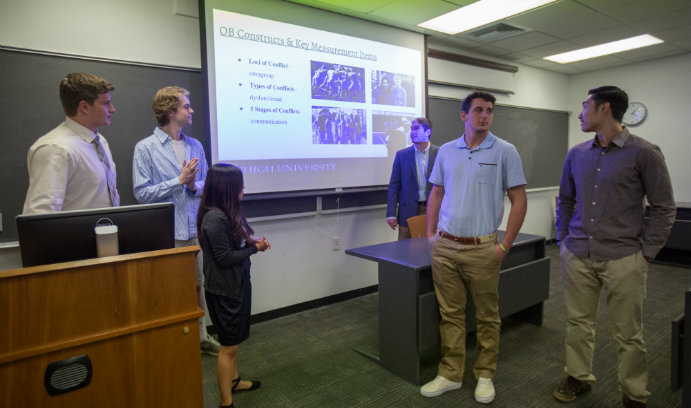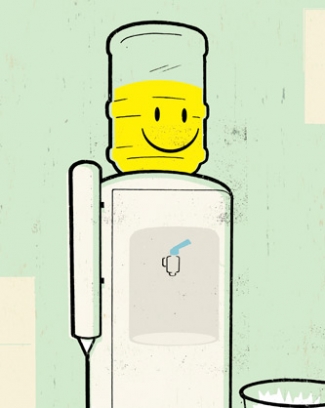Improving Organizational and Team Effectiveness

Teams of students in Assistant Professor Ozias Moore’s organizational behavior classes tackled real-life organizational problems and more as part of their coursework in spring 2017.
Photo: Christa Neu
How can a sandwich shop on the Lehigh campus improve customers’ satisfaction, speed up service and recover lost business? What can a nearby popular eatery do to stop high turnover among its managers? Among certain university organizations, what can be done to improve morale and member engagement?
Teams of students in Assistant Professor Ozias Moore’s organizational behavior classes tackled those real-life problems and more as part of their coursework in spring 2017. Applying theories and concepts they learned in the course, Managing and Leading People in Organizations, they conducted organizational field analyses that included data collection (surveys, interviews, work flow), data analyses and development of recommendations. Final presentations were in front of fellow students and industry executives.
One of the course objectives was to increase students’ abilities to understand and improve their teams and organizations once they enter the workforce. The course examined how employees impact their teams’ effectiveness and, in turn, how organizations and their managers impact employees’ attitudes, behaviors and effectiveness.
Students were charged with both diagnosing problems that were hampering 16 particular local businesses and on-campus groups—and developing plans to resolve those issues.
“These are people’s lives we are impacting and business outcomes we are looking to improve,” Moore said, underscoring the importance of understanding how people and groups interact within an organization. “You can not only make people’s lives happier but also improve individual, team and organizational outcomes.
“There’s no perfect organization,” Moore acknowledged. “People come and go.” But he added that it’s important to understand how people and groups interact within an organization because those interactions can influence a company’s performance.
He pointed to the successful hiring strategies of the online retailer Zappos, which strives to find employees who will be a cultural fit as well as have the talents to do their job. As part of the company’s hiring strategies, according to Business Insider, out-of-town recruits are assessed, in part, on how well they treat the van driver who ferries them from the airport to Zappos’ Las Vegas headquarters. In contrast, Moore pointed to a spate of negative publicity about the culture at Uber, which struggled to fix its problems.
“You need to navigate the environment,” added Kelly Payne ’97, senior project manager of organizational effectiveness for the Lehigh Valley Health Network. She helped review student presentations and provided feedback. “Missteps can cost your reputation, your company or both,” she said.
One student team, for its final project, examined a popular restaurant near Bethlehem that employs 25 people but had trouble holding on to managers. In five years, there had been four. The students surveyed waiters, busboys and hostesses and used employees’ feedback to form their recommendations: Identify the traits a manager should possess; improve applicant screening to determine whether a person would be “a good fit” at the restaurant; consider monetary incentives to keep a manager engaged; and hold monthly meetings to increase employee interaction.
Another team analyzed the high turnover among a small but very visible campus group. What led at least two members to quit mid-season each year? Several in the group felt their voices weren’t being heard, which contributed to conflicts, surveys showed. The team made several recommendations for unifying the group and bolstering morale: group dinners, a suggestion box and a recognition program.
The students also experienced the problems that can arise in assessing organizational behaviors, such as bias in survey questions. One team found that employees at the company they were analyzing were reluctant to disclose any issues with workflow, for example, and they had to develop other strategies. “This is hard work,” Moore said. “There are barriers to change.”
“My main takeaway is the ability I gained to recognize these management flaws and to understand their origin,” said Kristin Kidd ’19. “I also gained insight on how these problems can be addressed. …It is more important to share your ideas about team growth rather than to stay silent and avoid conflict.”
Haley Morris ’20 appreciated putting theory into practice. “When we study in class, it is easy to memorize concepts and definitions, but this experience really allowed us to apply our skills.”
The projects had significance beyond the classroom, as the teams shared their recommendations with the groups and workplaces they analyzed.
Posted on:


